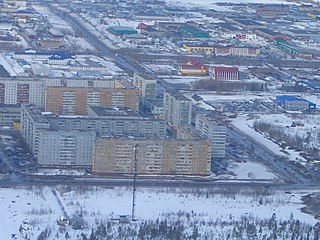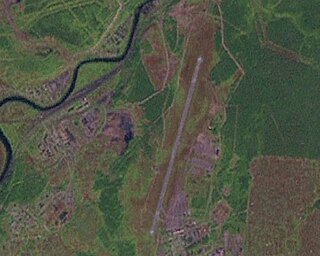
The Tupolev Tu-154 is a three-engine medium-range narrow-body airliner designed in the mid-1960s and manufactured by Tupolev. A workhorse of Soviet and (subsequently) Russian airlines for several decades, it carried half of all passengers flown by Aeroflot and its subsidiaries, remaining the standard domestic-route airliner of Russia and former Soviet states until the mid-2000s. It was exported to 17 non-Russian airlines and used as a head-of-state transport by the air forces of several countries.
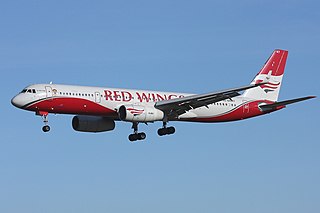
The Tupolev Tu-204 is a twin-engined medium-range jet airliner capable of carrying 210 passengers, designed by Tupolev and produced by Aviastar-SP and Kazan Aircraft Production Association. First introduced in 1989, it is intended to be broadly equivalent to the Boeing 757, with slightly lower range and payload, and has competitive performance and fuel efficiency in its class. It was developed for Aeroflot as a replacement for the medium-range Tupolev Tu-154 trijet. The latest version, with significant upgrades and improvements, is the Tu-204SM, which made its maiden flight on 29 December 2010.
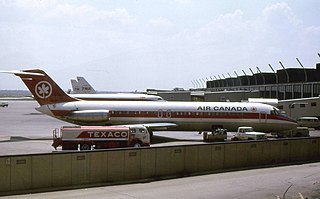
Air Canada Flight 797 was an international passenger flight operating from Dallas/Fort Worth International Airport to Montréal–Dorval International Airport, with an intermediate stop at Toronto Pearson International Airport. On 2 June 1983, the McDonnell Douglas DC-9-32 operating the service developed an in-flight fire behind the lavatory that spread between the outer skin and the inner decor panels, filling the plane with toxic smoke. The spreading fire also burned through crucial electrical cables that disabled most of the instrumentation in the cockpit, forcing the plane to divert to Cincinnati/Northern Kentucky International Airport. Ninety seconds after the plane landed and the doors were opened, the heat of the fire and fresh oxygen from the open exit doors created flashover conditions, and the plane's interior immediately became engulfed in flames, killing 23 passengers who had yet to evacuate the aircraft.

A water landing is, in the broadest sense, a landing on a body of water. Some aircraft such as floatplanes land on water as a matter of course.

UTair Flight 471 was a scheduled domestic passenger flight of a Tupolev Tu-134 on March 17, 2007, that suffered heavy structural damage during a hard landing at Samara Kurumoch Airport near Samara, Russia. Of the 50 passengers and 7 crew members on board, 6 people were killed and 20 injured when the aircraft broke apart. The plane was flying from the Siberian city of Surgut to Samara and then to Belgorod.
CJSC "Air Company ALROSA", formerly Alrosa Mirny Air Enterprise is an airline from Mirny, Russia. Its bases are at Mirny Airport and Polyarny Airport, with a focus city at Lensk Airport. The airline operates scheduled and chartered domestic flights.

Malév Flight 262 was a flight from Budapest Ferihegy International Airport to Thessaloniki International Airport. On 4 July 2000, a Tupolev Tu-154, belonging to Malév Hungarian Airlines, used on this flight performed a gear-up touchdown during the landing at Thessaloniki, skidded on the runway, but was able to take off and land normally after a go-around. No injuries were reported.

Aeroflot Flight 3352 was a Tupolev Tu-154 airline flight on a domestic route from Krasnodar to Novosibirsk, with an intermediate landing in Omsk. While landing at Omsk Airport on Thursday, 11 October 1984, the aircraft crashed into maintenance vehicles on the runway, killing 174 people on board and 4 on the ground. While a chain of mistakes in airport operations contributed to the accident, its major cause was an air traffic controller falling asleep on duty. As of 2019, this remains the deadliest aviation accident on Russian territory.
This is a list of aviation-related events from 2009:
This is a list of aviation-related events from 2010:
Air France has been in operation since 1933. Its aircraft have been involved in a number of major accidents and incidents. The worst accident of the airline occurred on June 1, 2009, when Air France Flight 447, an Airbus A330-203, crashed into the Atlantic Ocean with 228 fatalities. A selected list of the most noteworthy of these events is given below.

Taban Air Flight 6437 was a scheduled domestic flight that crashed on landing at Mashhad, Iran on 24 January 2010. All 170 people escaped from the burning aircraft without loss of life. Most of the passengers were pilgrims returning from visiting holy sites in Iraq.

Aviastar-TU Flight 1906 was a Tupolev Tu-204, registration RA-64011, which crash-landed due to pilot error while attempting to land at Domodedovo airport, Moscow, Russia, in heavy fog and poor visibility. The aircraft was on a ferry flight from Hurghada International Airport, Egypt to Domodedovo. There were no passengers on board and all eight crew survived the accident. Four crew members were seriously injured and taken to a hospital, while others suffered minor injuries. The accident was the first hull loss of a Tu-204 and the first hull loss for Aviastar-TU.

Henan Airlines Flight 8387 (VD8387/KPA8387) was a domestic flight operated by Henan Airlines from Harbin Taiping International Airport to Yichun Lindu Airport, both located in Heilongjiang province, China. On the night of August 24, 2010, the Embraer E-190-100 LR operating the route crashed on approach to Yichun Lindu with 91 passengers and 5 crew members on board. This was the first hull-loss and the first accident with fatalities involving an Embraer E-190 and as of 2019, the deadliest.

Dagestan Airlines Flight 372 was a scheduled commercial flight between Moscow's Vnukovo Airport and Makhachkala, Russia. On 4 December 2010, the Tupolev Tu-154 operating the flight skidded off the runway following an emergency landing at Domodedovo Airport, 45 km south-east of Vnukovo. Two people on board were killed.
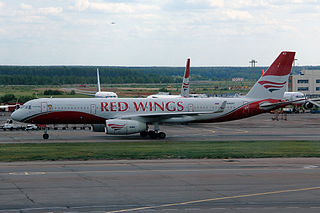
Red Wings Airlines Flight 9268 was a Tupolev Tu-204-100V passenger jet that on 29 December 2012 crashed on landing at Moscow Vnukovo Airport, Russia, following a repositioning flight from Pardubice Airport, Czech Republic. There were no passengers on board, but 5 of the 8 crew members were killed when the aircraft hit a ditch and highway structures after overrunning the runway.

Aeroflot Flight 3519 was a Tupolev Tu-154B-2 airline flight on a domestic route from Krasnoyarsk to Irkutsk on 23 December 1984. Shortly after takeoff, the No. 3 engine caught fire, and the airplane crashed during an emergency landing. 110 people were killed, and there was one survivor. The aircraft was destroyed in the crash.



